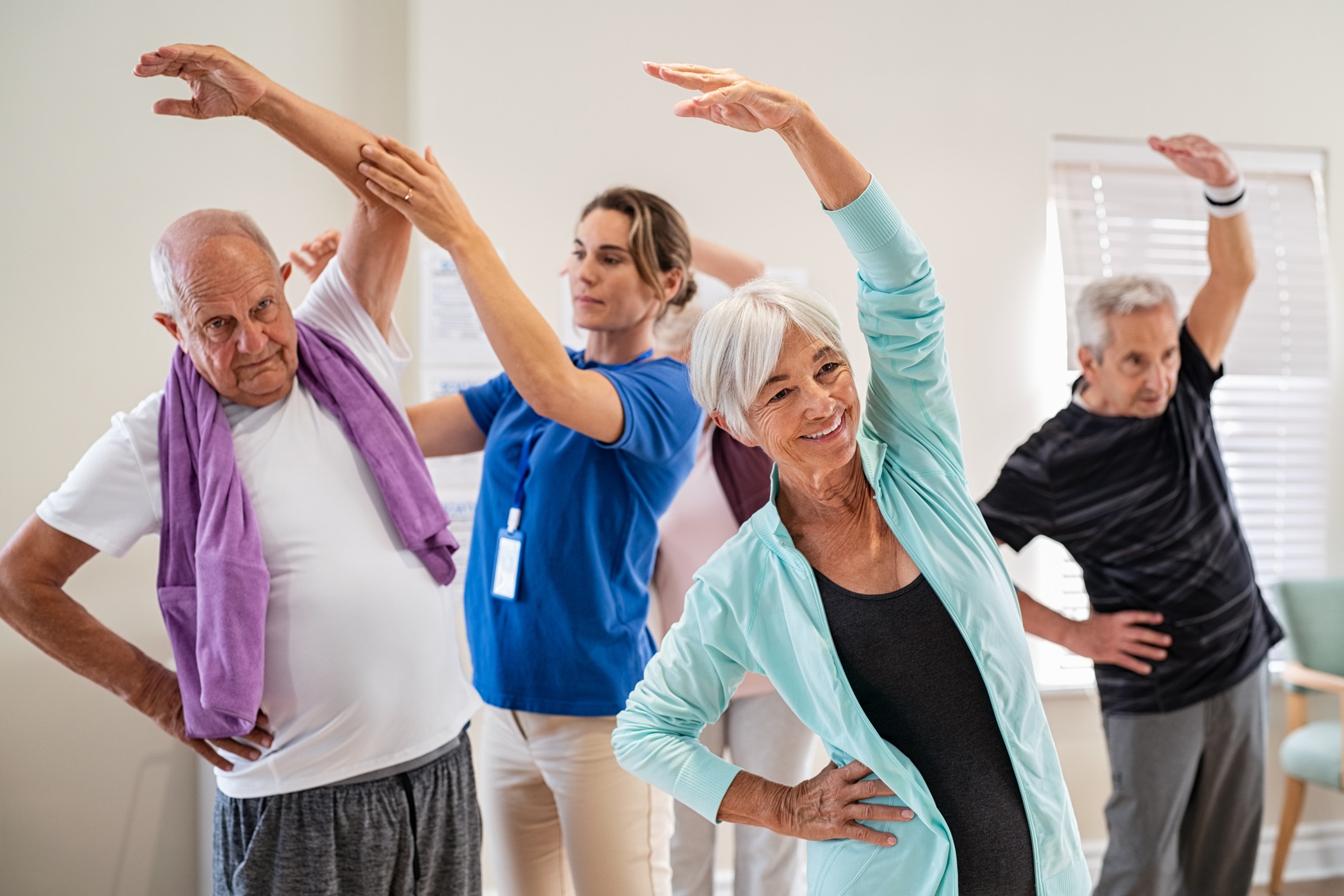See for yourself the many benefits of living at One Lincoln Park – schedule your visit today.

Setting and Keeping Fitness Goals for Seniors
Exercise is essential to health, and for seniors, it is especially important. As we age, our bodies lose muscle mass, bones weaken, and balance and agility decrease. But by exercising regularly, seniors can rebuild and sustain their health and physical strength, making an active and rewarding retirement possible. The trick is knowing how much and what exercise to do, and how to set and keep fitness goals. Here are tips for starting and keeping exercise goals.
How much exercise is best for seniors?
According to the “Physical Activity Guidelines for Americans” healthy older adults reap substantial benefits from regular exercise. These include better balance and mobility and lower risk of chronic conditions like high blood pressure, cardiovascular disease, some cancers, and dementia, anxiety, and depression.
That said, the Guidelines recommend that all active adults (including seniors) “should do at least 150 minutes (2 hours and 30 minutes) to 300 minutes (5 hours) a week of moderate-intensity, or 75 minutes (1 hour and 15 minutes) to 150 minutes (2 hours and 30 minutes) a week of vigorous-intensity aerobic physical activity, or an equivalent combination of moderate- and vigorous-intensity aerobic activity. Preferably, aerobic activity should be spread throughout the week.”
In general, seniors should work out at least three days a week, and one rule of thumb noted in the Guidelines is that “2 minutes of moderate-intensity activity counts the same as 1 minute of vigorous activity.”
To get an idea of the amount of actual physical activity a senior gets every day, the NIH’s Activity Log: Find Your Starting Point worksheet can help to establish a baseline.
Which exercises to choose
The different types and intensities of exercise can sometimes make goal setting tricky, especially when starting from scratch. While any type of exercise is good, certain exercises are better for meeting specific goals. As noted above, the Guidelines divide exercise into two groups: moderate-intensity activities and vigorous-intensity activities.
Starting out with moderate-intensity exercises like brisk walking at 2.5 miles per hour or faster, ballroom or line dancing, or recreational swimming can help seniors get started. As stamina increases, vigorous-intensity exercises like jogging/running, swimming laps, and jumping rope can be added. Exercises like bicycling, tennis and swimming can all begin at slower rates and then increased to achieve greater distance, speed, and endurance. For an overview of exercises that meet specific needs, the NIH article “Four Types of Exercise Can Improve Your Health and Physical Ability.”
Setting exercise goals
Exercise should be performed regularly to reap the health benefits, so goal setting is key to success. While some would say, “Just do it!,” having goals can serve as a great motivator. To begin, the National Institutes of Health article, “How Older Adults Can Get Started with Exercise” recommends first setting short-term goals. For example, if walking is on the list, a new pair of shoes may be needed to avoid injury, or for those who want to swim or dance, a short-term goal would be locating a pool or class.
Next come long-term goals which should include a written daily or weekly calendar or activity log of exercises and associated time and distance goals, all of which can increase with time and strength. Many seniors may also want to try new exercises as they meet their goals to include more aerobic and strength training in their workouts. Use the NIH Goal Setting Worksheet to help get going.
Another way to set goals is by choosing a health condition to eradicate or minimize. Among these are obesity, high blood pressure, diabetes, osteoporosis, and depression. To learn more about how exercise can impact health concerns, check out the mayoclinic.org article, “Exercise and chronic disease: Get the facts.”
Keeping exercise goals
Exercise goals are only useful when they are actively pursued. One way to stay motivated is to start with small goals: It’s better to walk or swim less at first than to do nothing at all. Another is to exercise with a friend which is not only more fun but helps maintain consistency.
A very tangible motivator is to reward yourself when you hit a goal. For example, after losing 10 pounds maybe the reward is a new exercise outfit. Or if the goal is lower blood pressure the reward might be tickets to a concert or play.
Keep in mind as you pursue your exercise goals that life happens and missing a day or two is not the end of the world. Just get back into the routine and start up where you left off. More on motivation can be found in the Mayoclinic.org blog, “Fitness: Tips for staying motivated.”
To explore the full range of health benefits of exercise and physical activity, check out the NIH article, “Health Benefits of Exercise and Physical Activity,” which highlights why staying active is essential for older adults.
At One Lincoln Park, staying healthy is easy. Residents enjoy full access to our Senior Fitness Center, personalized wellness programs, and a variety of engaging classes like Zumba, chair yoga, and Tai Chi—all designed with seniors in mind.


